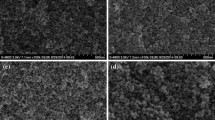Abstract
Hydrochloric acid (HCl) used as catalyst for the preparation of RF-aerogels leads to organic aerogels in very short gelation times. The gelation time can be varied from a few seconds to minutes. The wet gels can be dried under ambient conditions. By variation of the sol composition or catalyst concentration the microstructure of the dry gels can be modified. The aerogel densities are in the range of 210–410 kg/m3. The particle sizes, determined by scanning electron microscopy (SEM), are in the range of 700–1,500 nm. The particles look essentially spherical and their size spectrum can be close to monodisperse. The specific surface is measured by nitrogen adsorption (BET). Thermogravimetry (TGA) is employed to study the drying process, annealing reactions and decomposition of the aerogel into a carbon aerogel.






Similar content being viewed by others
References
Brück S, Ratke L (2003) J Sol–Gel Sci Technol 26(1):663
Brück S, Ratke L (2004) Giesserei Forschung 56(2):55
Voss D, Ratke L (2005) Giesserei Forschung 57(1):18
Ratke L, Brück S (2006) J Mater Sci 41:1019
Ratke L, Fricke J (2003) US Patent 6599953
Pekala RW, Alviso CT, Nielson JK, Tran TD (1995) Mat Res Soc Symp Proc 393:413
Bonsal RC, Donnet JB, Stoeckli HF (1988) Active carbon. Marcel Dekker, New York
Pekala RW, Kong FM (1989) Revue de Physique Appliquée, Colloque C4, Suppl. au n°4, Tome 24
Mayer ST, Kaschmitter JL, Pekala RW (1995) US Patent 5420168
Fischer U, Saliger R, Bock V, Petrivic R, Fricke J (1997) J Porous Mater 4:281
Brück S, Reuß M, Richter HE, Klein H, Haubner P, Ratke L (2004) International Symposium on Physical Sciences in Space, Toronto. May 2004, pp 23–27
Thiel J, Klein H, Brück S, Ratke L (2003) GIT Labor Fachzeitschrift 47:162
Fricke J (1988) J Non-Cryst Solids 100:169
Wiener D, Reichenauer G, Scherb T, Fricke J (2004) J Non-Cryst Solids 350:126
Job N, Théry A, Pirard R, Marien J, Kocon L, Rouzaud J-N, Béguin F, Pirard J-P (2005) Carbon 43:2481
Job N, Panariello F, Marien J, Crine M, Pirard J-P, Léonard A (2006) J Non-Cryst Solids 352:24
Czakkel O, Marthi K, Geissler E, Lázló K (2005) Microporous Mesoporous Mater 86:124
Tamon H, Ishizaka H, Yamamoto T, Suzuki T (1999) Carbon 37:2049
Kocklenberg R, Mathieu B, Blacher S, Pirard R, Pirard JO, Sorby R, Van den Bossche G (1998) J Non-Cryst Solids 225:8
Horikawa T, Hayashi J, Muroyama K (2004) Carbon 42:169
Fairén-Jiménez D, Carrasco-Marín F, Moreno-Castilla C (2006) Carbon 44:2301
Li W-C, Lu A-H, Schüth F (2005) Chem Mater 17:3620
Brandt R (2004) Sauer katalysierte, unterkritisch getrocknete Resorcin-Formaldehyd-Aerogele und daraus abgeleitete Kohlenstoff-Aerogele. Dissertation (PhD), Universität Würzburg
Brandt R, Petricevic R, Pröbstle H, Fricke J (2003) J Porous Mater 10:171
Brandt R, Fricke J (2004) J Non-Cryst Solids 350:131
Durairaj J (2005) Resorcinol: chemistry, technology and applications. Springer, Berlin
Brinker CJ, Scherer GW (1990) Sol–Gel science. Academic Press, London
Iler RK (1979) The chemistry of silica. Wiley & Sons, Inc., New York
Acknowledgement
This work is supported by Deutsche Forschungsgemeinschaft (DFG)/Bonn (RA537/8-1).
Author information
Authors and Affiliations
Corresponding author
Rights and permissions
About this article
Cite this article
Reuß, M., Ratke, L. Subcritically dried RF-aerogels catalysed by hydrochloric acid. J Sol-Gel Sci Technol 47, 74–80 (2008). https://doi.org/10.1007/s10971-008-1733-0
Received:
Accepted:
Published:
Issue Date:
DOI: https://doi.org/10.1007/s10971-008-1733-0




